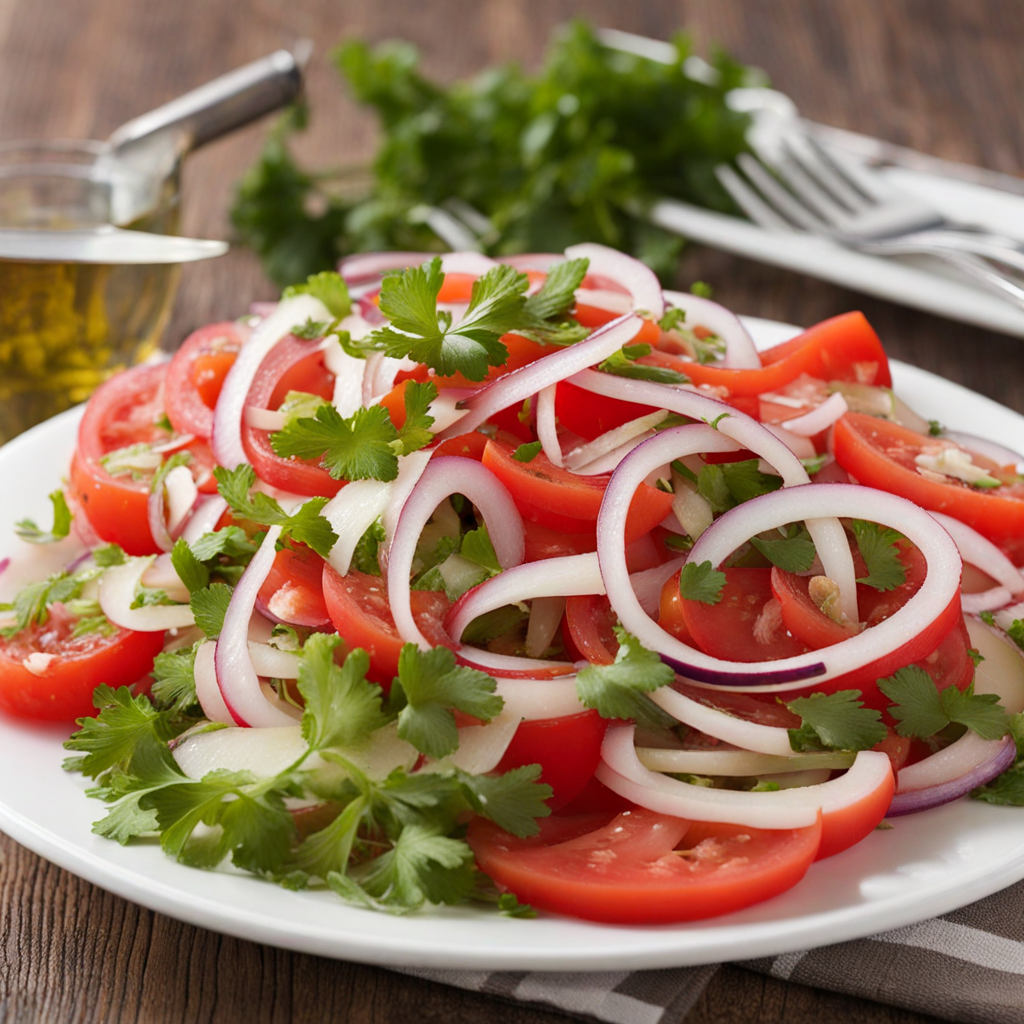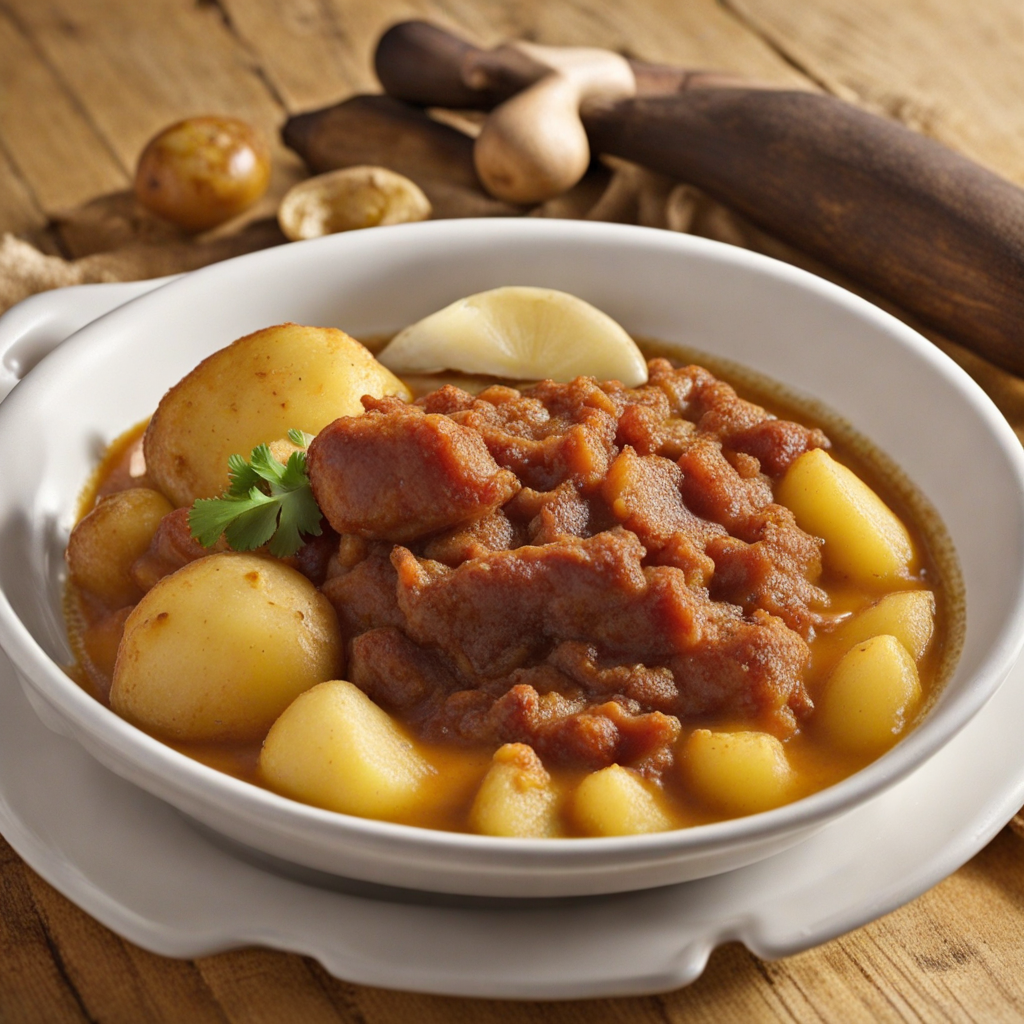Ensalada Chilena
Ensalada Chilena is a vibrant and refreshing salad that captures the essence of Chilean cuisine with its simple yet bold flavors. The core ingredients typically include ripe tomatoes, crunchy onions, and fresh cilantro, all tossed together to create a colorful medley that is both visually appealing and delicious. The tomatoes are usually at the peak of their ripeness, offering a juicy sweetness that contrasts beautifully with the sharpness of the onions, while cilantro adds a fragrant, herbal note that elevates the overall taste experience. A drizzle of olive oil and a squeeze of fresh lime or lemon juice brings the salad to life, enhancing the natural flavors and providing a zesty finish. One of the standout features of Ensalada Chilena is its versatility. While the traditional recipe is quite straightforward, it can be easily adapted to include additional ingredients such as avocado, bell peppers, or even corn, depending on personal preferences and seasonal availability. This adaptability allows home cooks to experiment and personalize the salad, making it a perfect accompaniment to a variety of main dishes, particularly grilled meats and seafood, which are staples of Chilean cuisine. The freshness of the salad acts as a palate cleanser, balancing out richer flavors and adding a lively crunch to any meal. The enjoyment of Ensalada Chilena lies not only in its taste but also in its celebratory nature. Often served during family gatherings, barbecues, or festive occasions, this salad embodies the spirit of sharing and togetherness that is central to Chilean culture. Each bite offers a burst of freshness that transports you to the sun-soaked landscapes of Chile, making it a delightful dish for anyone looking to explore new culinary horizons. The combination of simple ingredients, vibrant colors, and bold flavors makes Ensalada Chilena a must-try for those seeking to expand their palate.
How It Became This Dish
Ensalada Chilena: A Culinary Journey Through Chile's Heart Ensalada Chilena, or Chilean salad, is a vibrant and refreshing dish that encapsulates the spirit of Chilean cuisine. With its simple yet flavorful blend of ingredients, this salad is not just a staple on tables across the country; it is a symbol of Chilean identity and culinary tradition. To understand the origins and cultural significance of Ensalada Chilena, we must delve into the history of Chilean gastronomy, the influences that shaped it, and how this salad has evolved over time. Origins of Ensalada Chilena The roots of Ensalada Chilena can be traced back to the indigenous Mapuche people who inhabited the central and southern regions of Chile long before the arrival of Spanish colonizers in the 16th century. The Mapuche had a profound understanding of local agriculture and cultivated a variety of crops such as potatoes, quinoa, and corn. They also foraged for wild greens and herbs, creating dishes that celebrated the natural bounty of their land. The introduction of European ingredients during the colonial period had a significant impact on Chilean cuisine. Spanish settlers brought with them onions, tomatoes, and various spices, which gradually made their way into local cooking practices. The fusion of indigenous ingredients with Spanish culinary techniques laid the groundwork for what would eventually become Ensalada Chilena. The salad itself typically consists of fresh tomatoes, onions, and cilantro, often seasoned with olive oil, vinegar, and salt. The combination of these ingredients reflects the agricultural richness of Chile, particularly its favorable climate for growing tomatoes and onions. The salad embodies the essence of Chilean cooking—simple, fresh, and flavorful—while also showcasing the influence of both indigenous and European culinary traditions. Cultural Significance Ensalada Chilena is more than just a dish; it is a cultural emblem that represents the Chilean way of life. In a country known for its diverse landscapes—from the arid Atacama Desert in the north to the lush valleys and temperate rainforests in the south—this salad symbolizes the connection between the land and its people. It is often served as a side dish during family gatherings, barbecues, and traditional Chilean asados (grilled meat gatherings), where it complements various meats and other side dishes. The salad's popularity can be attributed to its versatility and the ease with which it can be prepared. Freshness is key, and the use of seasonal produce ensures that each bite bursts with flavor. Moreover, Ensalada Chilena is a reflection of the Chilean ethos of “comer bien” (eating well), emphasizing the importance of wholesome, unprocessed foods. In Chile, the salad is often enjoyed alongside staple dishes such as empanadas, pastel de choclo (corn pie), and various grilled meats. It serves as a refreshing counterpoint to heavier fare and is a reminder of the importance of balance in a meal. The salad's vibrant colors and fresh ingredients also make it a feast for the eyes, reinforcing the Chilean belief that food should not only taste good but also look appealing. Development Over Time As Chilean society evolved through the 19th and 20th centuries, so too did the Ensalada Chilena. The agrarian reforms and increased urbanization during this period led to changes in dietary habits and food availability. With the growth of cities and the rise of a middle class, access to fresh produce became more widespread, allowing the salad to gain even more prominence in everyday meals. The salad's ingredients, especially tomatoes and onions, became more accessible due to advances in agricultural practices and transportation. The introduction of varieties of tomatoes suited to different climates and conditions helped ensure that Chileans could enjoy fresh salads year-round. Additionally, the rise of supermarkets and local markets made it easier for families to purchase fresh ingredients, further entrenching the salad in Chilean culinary culture. In recent decades, Ensalada Chilena has also been influenced by global food trends. The rise of health consciousness among Chileans has led to a renewed interest in fresh, organic produce and plant-based diets. This shift has further solidified the salad's place in the national diet, as it aligns perfectly with contemporary values of health and sustainability. Modern interpretations of the salad may include additions such as avocado, bell peppers, or even fruits like mango, allowing for innovation while still honoring the traditional roots of the dish. Moreover, as Chilean cuisine has gained international recognition, Ensalada Chilena has made its way onto the menus of restaurants beyond the borders of Chile. Chefs and food enthusiasts around the world have embraced this simple yet delicious salad, showcasing it as a representation of Chilean culinary heritage. With its fresh ingredients and vibrant flavors, it has become a favorite among those seeking authentic Latin American cuisine. Ensalada Chilena Today Today, Ensalada Chilena is a beloved dish that continues to evolve while maintaining its core elements. It is a staple in homes across Chile, often enjoyed during celebrations and everyday meals alike. The salad's simplicity allows for personal touches, and each family may have its own variation, reflecting regional differences and personal preferences. As Chileans increasingly prioritize local and seasonal produce, the importance of Ensalada Chilena as a vehicle for celebrating Chile's agricultural diversity cannot be overstated. From the coastal regions that provide fresh seafood to the fertile valleys that yield an abundance of fruits and vegetables, the salad serves as a reminder of the rich resources available in the country. In conclusion, Ensalada Chilena is a dish steeped in history and cultural significance. From its indigenous roots to its status as a modern culinary staple, this salad embodies the essence of Chilean cuisine: fresh, flavorful, and deeply connected to the land. As it continues to evolve, Ensalada Chilena remains a symbol of national pride, reflecting the heart and soul of Chilean culture. Whether enjoyed in a bustling market, at a family gathering, or in a fine dining restaurant, this salad will always be a testament to the enduring legacy of Chilean culinary traditions.
You may like
Discover local flavors from Chile







